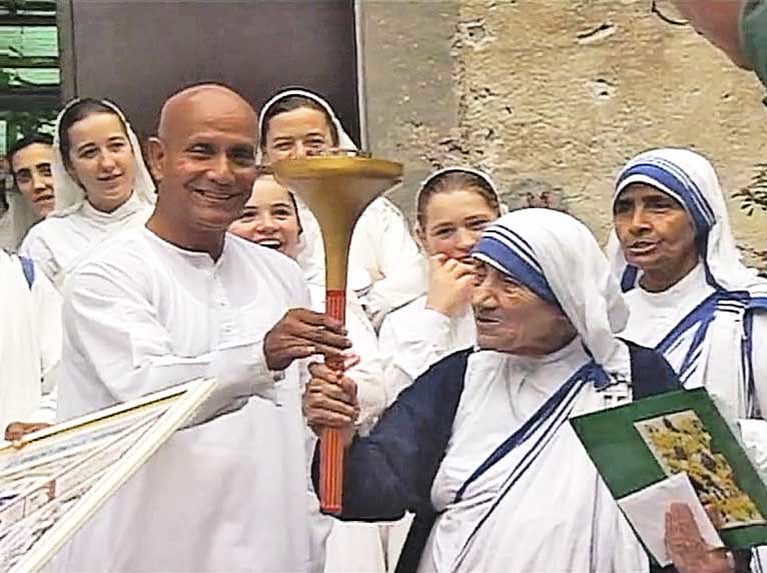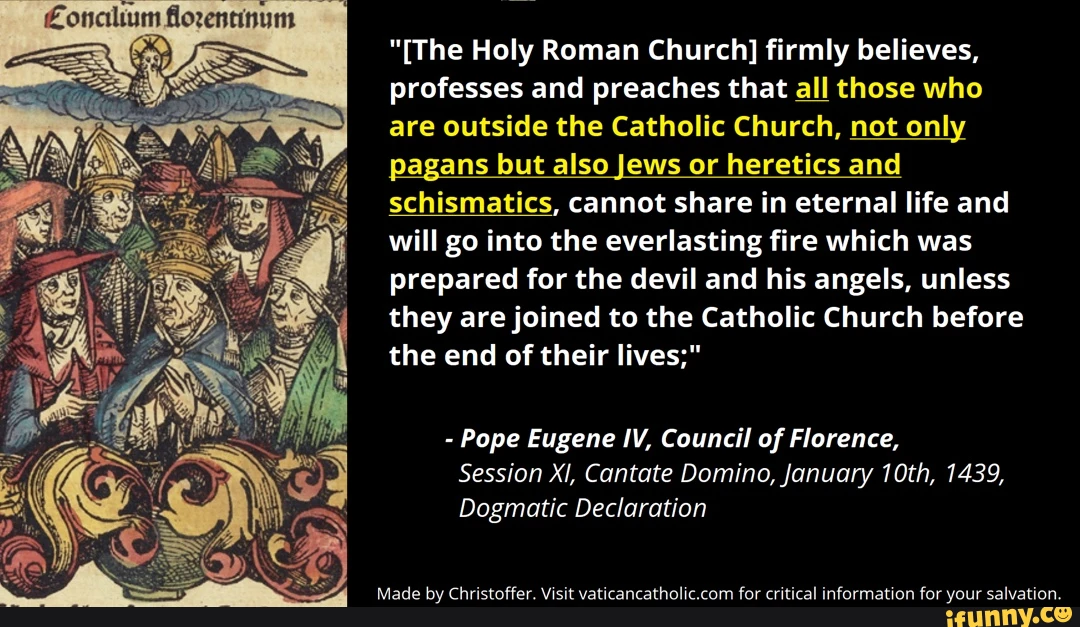Setem-15-cem-sogglem-santam
Setem-15-acem Sogglem Santam
Page URL: https://ocaminhodossantos.blogspot.com/2023/09/setem-15-acem-sogglem-santam.html.- Nossa Senhora da Dores or Our Lady of Dolours, or Our Lady of Sorrows
- Prophet St. Tommasuccio of Foligno
- Also St. Catherine of Genoa, And Others.
MAJOR AND/OR GREAT FEASTS
Flee From Satan's Church
When Pope Pius XII died in October 1958, Public, Pertinacious and Manifest Satanists seized the Vatican Basilica and from there masquerade as the Catholic Church.However, Catholic Law excludes Public, Pertinacious and Manifest Heretics and Apostates from the Catholic Church, and all their pretended "acts" are null and void.
All who observe and pretend to legitimize the Pretensions and Masquerades of these Satanists, thereby certify themselves satanists, and that their "gods" are the Demons Ganpati, Allah, etc., the "gods" of the Accursed Latrocinium of "Vatican2."
God Demands Obedience And Excludes All False 'gods'
 Thou shalt not have strange gods before me." Exodus xx, 2-3; http://drbo.org/chapter/02020.htm
Thou shalt not have strange gods before me." Exodus xx, 2-3; http://drbo.org/chapter/02020.htmFor what participation hath justice with injustice?
Or what fellowship hath light with darkness?
And what concord hath Christ with Belial?
Or what part hath the faithful with the unbeliever?
And what agreement hath the temple of God with idols?
For you are the temple of the living God; as God saith: I will dwell in them, and walk among them; and I will be their God, and they shall be my people.
Wherefore, Go out from among them, and be ye separate, saith the Lord, and touch not the unclean thing:
And I will receive you; and I will be a Father to you; and you shall be my sons and daughters, saith the Lord Almighty." (2 Corinthians vi, 14 fl.; http://drbo.org/chapter/54006.htm)

And they said: we will not walk.
And I appointed watchmen over you, saying: Hearken ye to the sound of the trumpet.
And they said: We will not hearken." (Jeremias vi, 16-17; http://drbo.org/chapter/28006.htm)
God's Firewall Against Satan and Satan's Lies of Pretended "New Gospels" eg Montanism, Mahomettanism, Waldensianism, Lutheranism, Calvinism, Modernism, etc.

Which is not another, only there are some that trouble you, and would pervert the gospel of Christ.
But though we, or an angel from heaven, preach a gospel to you besides that which we have preached to you, let him be accursed. As we said before, so now I say again: If any one preach to you a gospel, besides that which you have received, let him be accursed." Galatians 1, 6-9 http://drbo.org/chapter/55001.htm

He that continues in the doctrine, the same has both the Father and the Son.
If any man come to you, and bring not this doctrine, receive him not into the house nor say to him, God speed you (Best wishes).
For he that says unto him, God speed you, takes part with his wicked works." 2nd Epistle of St. John i, 9-11; http://drbo.org/chapter/70001.htm
Proof of Satanism
Please read this page for context: https://www.traditioninaction.org/HotTopics/b021ht_Guru.htm.That Antipopes Roncalli, Montini, Luciani, Wojtyla, Ratzinger & Bergoglio were and are Satanists is evident from the Bible, particularly the First Commandment.
The ability to discern and distinguish between Christians and Satanists is proof of whether one is a Christian or a Satanist.
The refusal to acknowledge that the Antipopes Roncalli, Montini, Luciani, Wojtyla, Ratzinger & Bergoglio were and are Public, Pertinacious and Manifest Satanists and heads of a non-Catholic sect, is proof that one is a Satanist, a public enemy of the Living God.
Nossa Senhora da Dores in Portuguese, Dores Saibinn or Duquist Saibinn in Concannim, or Our Lady of Dolours, or Our Lady of Sorrows
The Catholic Church twice commemorates the Seven Sorrows of the Blessed Virgin Mary, the first on the Friday in the Passion Week, that is one week before Good Friday, and the second on the feast of the Seven Sorrows of our Lady, which is celebrated today, September 15. To understand this double liturgy, we must know that Mary is also the Mother of the Catholic Church, the Mystical Body of Jesus Christ. In 1233 AD, seven young men in Tuscany, Italy founded the Servite Order ("Order of the Servants of Mary"). Five years later, the Servites took up the Seven Sorrows of Mary, as the principal devotion of their Order.
On August 15, 1233 AD, seven Florentine nobles enrolled in the Merchants' Guild and poet-actors of the Laudesi company participated in a ceremony to express their love for Mary in laudi in front of an image painted on a roadside wall, as jesters did, when, suddenly they saw the image come to life, Our Lady appear pained and dressed in mourning for the fratricidal hatred that divided Florence. These young men threw down their weapons, put on a mourning dress in imitation of her, established themselves as the Company of Mary of Sorrows, also known as the Servites, and retreated to penance and prayer on Monte Sanario.
A feast of Our Lady of Sorrows was also instituted by a Provincial Synod of Cologne, Germany, in 1413 AD, as a response to the Hussites who had gashed the icon of Our Lady of Czestochowa with their swords. The feast later spread to several other countries, and was extended to the whole Church in 1727 AD by Pope Benedict XIII, who assigned it to the Friday in Passion Week, one week before Good Friday.
The second feast, that is today's feast, was granted to the Servite Order in 1668, and this feast was extended to the Universal Church by Pope Pius VII, after his return from the imprisonment and exile by Napoleon Bonaparte, which had lasted from 1809 to 1814.
This feast was instituted in remembrance of the Captivity of the Catholic Church in the person of the Vicar of Christ. On perusing the register of the apostolic decrees concerning sacred rites, the reader is astonished to find a long and unusual interruption lasting from March 20, 1809 to September 18, 1814, at which latter date is entered the decree instituting, on the Sunday following the Feast of the Exaltation of the Holy Cross, a second Commemoration of Our Lady's Sorrows. 1809 -1814, five sorrowful years, during which the government of Christendom was suspended; years of blood which beheld the Man-God agonizing once more in the person of His Vicar, suffering in the captivity of the Infidel Italian bandit, Napoleon Buonaparte. But the Mother of Sorrows was still standing beneath the Cross, offering to God the Church's sufferings; and when the trial was over, Pope Pius VII, knowing well whence the mercy had come, dedicated this day to Mary as a fresh memorial of the day of Calvary.
Today's feast was originally assigned to the third Sunday in September. Later in 1913 AD, Pope St. Pius X moved the feast to September 15, the day after the Feast of the Exaltation of the Holy Cross, which is also the octave day of the Nativity of the Blessed Virgin Mary, thus emphasizing the fact that Her Sorrows were life-long.
The first Feast, that of Friday in the Passion Week, one week before Good Friday, honors mainly Mary's compassion on Calvary, and has a distinct origin from today's Feast, which honors her lifelong Sorrows.THE SEVEN SORROWS OF OUR LADY
- The Prophecy of St. Simeon.
- The Flight Into Egypt.
- The Loss of Child Jesus in the Temple.
- Meeting with Jesus Carrying His Cross.
- The Crucifixion of Jesus.
- The deposition of the Dead Body of Jesus from the Cross.
- The Burial of Jesus.
- "I will grant peace to their families."
- "They will be enlightened about the Divine Mysteries."
- "I will console them in their pains and I will accompany them in their work."
- "I will give them as much as they ask for as long as it does not oppose the adorable will of my Divine Son or the sanctification of their souls."
- "I will defend them in their spiritual battles with the infernal enemy and I will protect them at every instant of their lives."
- "I will visibly help them at the moment of their death — they will see the face of their mother."
- "I have obtained this grace from my divine Son, that those who propagate this devotion to my tears and dolors will be taken directly from this earthly life to eternal happiness, since all their sins will be forgiven and my Son will be their eternal consolation and joy."
- That those who before death invoke the Blessed Mother in the name of her Sorrows, should obtain true repentance of all their sins.
- That He would protect in their tribulations all who remember this devotion, and that He would protect them especially at the hour of death.
- That He would impress upon their minds the remembrance of His Passion, and that they should have their reward for it in Heaven.
- That He would commit such devout clients to the hands of Mary, so that she might obtain for these souls all the graces she wanted to lavish upon them.
- + The Holy Martyrs of Adrianopolis: Saints Asclepiodotus, Maximus and Theodorus, martyred in the persecutions of Emperor Maximianus, 310 A.D., at Adrianopolis (Adrianople), now Edirne "in Turkey."
- + The Holy Martyrs of Cordoba: Saints Emilas and Jeremias, tortured and murdered, martyred by the Mahomettan Infidels under Abderrahman in 852 A.D.
- + The Holy Martyrs of Morocco: Saints Denis, Francis, Ildefonse, James, John and Santus (Sancho), a group of six Mercedarians who were taken captive by Mahomettan Infidels near Valencia, Spain and taken to Morocco, where they continued preaching Christianity, for which they were tortured and crucified in 1437 A.D. in Morocco.
- + The Holy Martyrs of Noviodunum: Saints Gordianus, Macrinus, Stratonius and Valerianus, martyred at Noviodunum in Lower Moesia, Roman Empire, now Isaccea, Romania, on the eastern border with Ukraine.
- + St. Leobinus, also called Lubin, )[1] [2] was a hermit, abbot, and bishop. Born in a peasant family, he became a hermit and a monk of Micy Abbey before being ordained a priest. He was then elected abbot of Brou and in 544, became Bishop of Chartres, succeeding Etherius with the consent of king Childebert I. Leobinus died in the Lord, March 14, 557 A.D., today is most probably a translation of his relics.
- + St. Nicetas the Goth, a convert, brought to the faith by the missionary and translator Ulphilas before Ulphilas became an Arian. Burned alive 370 A.D. in the persecutions of King Athanaric, his relics were enshrined in Mopsuestria, Cilicia, September 15, 375 A.D. His left arm is enshrined in the 12th century abbey of Saint Nicetas in Melendugno, Lecce, Italy.
- + St. Aichard. He was the son of a military officer in the court of King Clotaire II. Educated at a monastery in Poitiers, France. Destined by his father for the military, Aichard felt a call to the religious life. His mother convinced the rest of the family to give him a choice, and he became a monk at St. Jouin Abbey, Ansion, Poitou for 39 years. Prior of Jumièges Abbey. Abbot of Jumièges, a house with 900 monks where his strict personal observance of the Order's rule set an example that rippled through the rest of the house. Died in the Lord, 687 at Jumièges Abbey.
- + St. Albinus, was bishop of Lyon, France from 381 to 390. He built the Cathedral of St. Stephen there. Died in the Lord, 390 AD.
- + St. Anthony Mary Schwartz, founder of the Congregation of Christian Workers of Saint Joseph Calasanz at Vienna on 24 November 1889. Died in the Lord, September 15, 1929 in Vienna. Not yet beatified or canonized by a Catholic Pope.
- + St. Apres, he was a lawyer, known for his skill, integrity and devotion to justice. He gave up his profession to became a priest. He was then made bishop of Toul, France. Died in the Lord, 507 AD. He was interred in the basilica in Toul.
- + St. Baldo or Bond, a student of St. Artemius of Sens. Hermit in Sens, France.
- + St. Camillus, baptized as John Baptist Costanzo, Jesuit missionary in Japan, he was tortured and murdered, martyred, burned to death by the Buddhists, September 15, 1622 in Tabira, Nagasaki, Japan. He was beatified May 7, 1867 AD by Pope Pius IX.
- + St. Catherine of Genoa, Apostle of the Souls in Purgatory. Baptized as Caterina Fieschi Adorno, of a family of Genoese nobility, she was related to Pope Innocent V and Pope Adrian V. A pious and prayerful girl, she early felt a call to religious life, tried to enter a convent at age 13, was turned away because of her youth. At 16 she entered into an arranged marriage with a young Genoese nobleman, Julian Adorno. They were a childless couple, he was careless and unsuccessful as a husband and provider, often cruel, violent and unfaithful, and reduced them to bankruptcy. Catherine became indifferent to her faith, and fell into a depression. In 1473, while going to Confession in a convent in Genoa, Catherine was struck down by a vision, the revelation of God's love and her own sinfulness, and fell into a religious ecstasy; her interior state, and her contact with the truth she had received in the vision, stayed with her the rest of her life. She returned home, helped lead her husband to the faith, and the two lived together chastely the rest of their lives, working with the sick and poor till the death of Julian in 1497. She became a Franciscan tertiary, serving as a tertiary directress in 1490. Caught and survived the plague in 1493. Spiritual student of Fr. Cattaneo Marabotti in 1499, and he helped her to write and arrange descriptions of what she had seen and learned in her visions. It is her writings that have continued her fame today; during her canonization inquiry, the Holy Office announced that her writings alone were enough to prove her sanctity. Died in the Lord, September 15, 1510 at Genoa, Italy. Beatified April 6, 1675 by Pope Clement X. Canonized June 16, 1737 by Pope Clement XII.
- + St. Christian. He was born in Perugia to a noble family and seems to have received the religious habit from St. Dominic in Bologna, where he had been sent by his parents to attend university. According to Fontana, the same St. Dominic would have sent him to Perugia together with b. Nicola da Giovinazzo, to build a convent there. The two Dominicans won the hearts of the Perugians, who allowed them to choose the place for the construction of the church and the convent to be built at the expense of the municipality. In 1235, Gregory IX granted an indulgence to those who collaborated on the building which was completed in 1260 and consecrated by Clement IV in 1264, although the friars had begun to officiate it from 1240, dedicating it to St. Dominic and to St. Stephen the Protomartyr. In it Gregory IX canonized St. Elizabeth of Hungary, and Innocent IV canonized St. Peter Martyr. Fontana, speaking of the illustrious men of the convent of Perugia, includes Christian among those who's vitae sanclitate floruere, adding that he had particular devotion to St. Augustine, who, appearing to him, exhorted him to a more severe life of penance. He was prior of the Perugian convent and, as the obituary says, "quam plurimum gratus fratribus" and loved by his fellow citizens. He died about 1276, after having lived in the Order fifty-five years. He had a common burial with the St. Nicolaus da Giovinazzo in the church of St. Dominic. The Bollandists place him among the praermissi with these words: "Vitam cum titulo Beati ad hunc diem (September 15) dat Jacobillus in Sanctis Umbriae." Masetti and others also give him the title of blessed.
- + St. Eutropia, a saintly 5th century widow in Auvergne, now in France.
- + St. Hernan, a British refugee to escape the Anglo-Saxon invasion, he settled as a hermit at Loc-Harn in Brittany, which place was named after him.
- + St. Joseph Aviv (or Abibos), one of 13 (or 19) Assyrian monkish missionaries in Georgia, he was a disciple of St. John of Zedazeni, and founded and led as abbot a monastery in Alaverdi in Georgia. He is mentioned in Bessarion's The Saints of Georgia.
- + St. Marcellus. The massacre of the martyrs of Lyons with their bishop, St. Pothinus, took place during the persecutions of Marcus Aurelius in the year 177. Marcellus, a priest, we are told, by Divine intervention, managed to escape to Chalon-sur-Saone, where he was given shelter. His host was a pagan, and seeing him offer incense before images of Mars, Mercury, and Minerva, Marcellus remonstrated with and converted him. While journeying toward the North, the priest fell in with the governor Priscus, who asked him to a celebration at his house. Marcellus accepted the invitation, but when he found that Priscus was preparing to fulfill religious rites, he asked to be excused on the ground that he was a Christian. This raised an outcry, and the bystanders tried to kill Marcellus there and then by tying him to the tops of two young trees in tension and then letting them fly apart. The governor ordered him to make an act of worship before an image of Saturn. He refused, whereupon he was buried up to his middle in the earth on the banks of the Saone, and died in three days of exposure and starvation. Butler mentions with St. Marcellus, the martyr St. Valerian who is named in the Roman Martyrology on September 15th. He is said to have escaped from prison at the same time as Marcellus, and was beheaded for the Faith at Tournus, near Autun.
- + St. Maximillianus, bishop of Palermo, Sicily. Because he stood for orthodox Christianity, the Arian King Genseric exiled him to Tuscany, Italy, where he died due to the rigors of imprisonment. His relics were later translated to Palermo, Sicily. Some relics were later transferred to the church of San Maria Monticelli in Rome, and some of those relics were later transferred to Spoleto, Italy.
- + St. Meadhran, also called Merin, Merryn, Mirin and Mirren. A spiritual student of St. Comgall of Bangor. Evangelized the area of Strathclyde. Founded Paisley Abbey, now in Paisley, Renfrewshire, Scotland, and served as its first abbot. He is venerated in Ireland and Scotland. Died in the Lord, 620.
- + St. Melitina, in the persecution of emperor Antoninus Pius, under the governor Antiochus, she was twice taken into pagan temples and ordered to make sacrfices to idols; the idols would topple over. Her captors gave up, tortured and then executed her by beheading, in the 2nd century at Marcianopolis, Thrace. Her relics were enshrined on Lemnos Island in the Aegean Sea.
- + St. Nicomedes, a priest in Rome, Italy. Arrested for helping martyrs, and for giving them Christian burial. Martyred by being beaten to death with clubs c.71 at Rome, Italy. His catacomb is on the Via Nomentana, Rome, under the grounds of the Villa Patrizio. Some relics transferred to Milan and Parma in Italy.
- + St. Orlando (or Roland) da Medici. A member of the famous de Medici family. At around age 30, he retired from the world to live as a hermit in the Alpine forests, dressed in nothing more than a goatskin. Died in the Lord, September 15, 1386, he was buried at the Church of Busseto in Italy. Beatified September 25, 1853 by Pope Pius IX.
- + St. Pascal Penades Jornet, a priest in the archdiocese of Valencia, Spain, he was martyred by Communist terrorists September 15, 1936 in Carcer, Valencia, Spain. Not yet beatified or canonized by a Catholic Pope.
- + St. Paul Manna. A missionary to Toungoo, Eastern Burma. Worked in Burma until 1907 when his failing health forced his return to Italy. From there he spent the rest of his life encouraging clerical and lay missionaries through his writing, his work, his preaching. Director of Le Missioni Cattoliche in 1909. Started the publication of Propaganda Missionaria, a popular broadsheet newspaper, in 1914. Founded the Missionary Union of the Clergy in 1916, created with the idea of spreading missionary zeal throughout the faithful. Founded Italia Missionaria for young people in 1919. Founded Sacred Heart Seminary at Ducenta, Caserta, Italy in an effort to foster missionary vocations in southern Italy. Superior General of the Institute of Foreign Missions of Milan in 1924 which in 1926 was joined by Pope Pius XI to the Missionary Seminary of Rome to create the Pontifical Institute for Foreign Missions (P.I.M.E.). Worked from 1934 to 1936 to help found the Misssionary Sisters of the Immaculate, an offshoot of the P.I.M.I. Headed the International Secretariat for the Missionary Union of the Clergy from 1937 to 1941. Superior of the Italian Southern Province of P.I.M.E. in 1943. Publisher of the family missionary magazine Venga il tuo regno in 1943. Wrote in support of missionaries, developed techniques which have become standard today, and though he was tied to a desk in southern Italy, he worked as a missionary throughout his life. Died in the Lord September 15, 1952 at Naples, Italy. Not yet beatified or canonized by a Catholic Pope.
- + St. Porphyrius, an actor who, while performing in a play that mocked baptism, suddenly declared himself a Christian. Emperor Julian the Apostate was in the audience, was not amused, and had Porphyrius murdered on the spot, in 362 A.D.
- + St. Ribert, a monk, he was made Abbot of Saint-Valery-sur-Somme, France. He may also have been made a regionary bishop in Normandy & Picardy.
- + St. Ritbert, a monk, and then abbot of a monastery in Varennes, France. Died in the Lord, 690 A.D.
- + St. Tommasuccio of Foligno, he was a Franciscan friar, and a noted preacher in the Italian regions of Tuscany and Umbria, known for his prophecies. He was buried in the Franciscan church of St. Augustine in Foligno.
- + St. Valerianus. A refugee from the Massacre of the Christians led by Bishop St. Photinus or Pothinus, at Lyon. Was arrested preaching in Tournus, France, and was martyred by being beheaded in 178 A.D. in Tournus, France.
- + St. Vitus, he was a student of St. Albert, and lived as a Benedictine monk near Bergamo, Italy. Died in the Lord, 1095 A.D.
- + St. Vladislaus Miegon, a priest in the military ordinariate of Poland. Deported, imprisoned, tortured and martyred by the Nazis, September 15, 1942 AD at Dachau, Germany. Not yet beatified or canonized by a Catholic Pope.
- + Charles of Montegranelli.
GREAT FEASTS
MARIAN FEASTS
Collective of Martyrs
Translations
Individual Saints
Insufficient Information
OREMUS
Most Holy Mary, Mother of God, and our Mother, and all you Saints, Fathers and Mothers, Apostles, Martyrs, Confessors, Virgins, Popes, Bishops, Doctors, Abbots, Priests, Brothers and Sisters, Hermits, Monks, Teachers and Evangelists and Missionaries, Champions and Heroes of Jesus Christ, whose feasts are today, named and unnamed, we pray to you for your intercession and guidance, lead us away from error and evil and into the Grace and Love of God, that with your assistance, we may join you in Eternity with the Living God, we make this prayer through Jesus Christ Our Lord, Who Lives and Reigns, in the Unity of the Godhead, with the Father and the Holy Ghost, one God, forever and ever, Amen.Lúcío Mascarenhas.
Ministério Metamorfose: O Caminho dos Santos de Lúcío Mascarenhas. https://www.vaticaninexile.com.


